Strategic Management Report: Analysis of Starling Bank's Strategies
VerifiedAdded on 2022/12/26
|14
|3972
|3
Report
AI Summary
This report provides a comprehensive strategic management analysis of Starling Bank, a prominent player in the banking and financial services sector. The report begins with an introduction to strategic management and then delves into the macro environment, utilizing PESTLE analysis to assess polit...
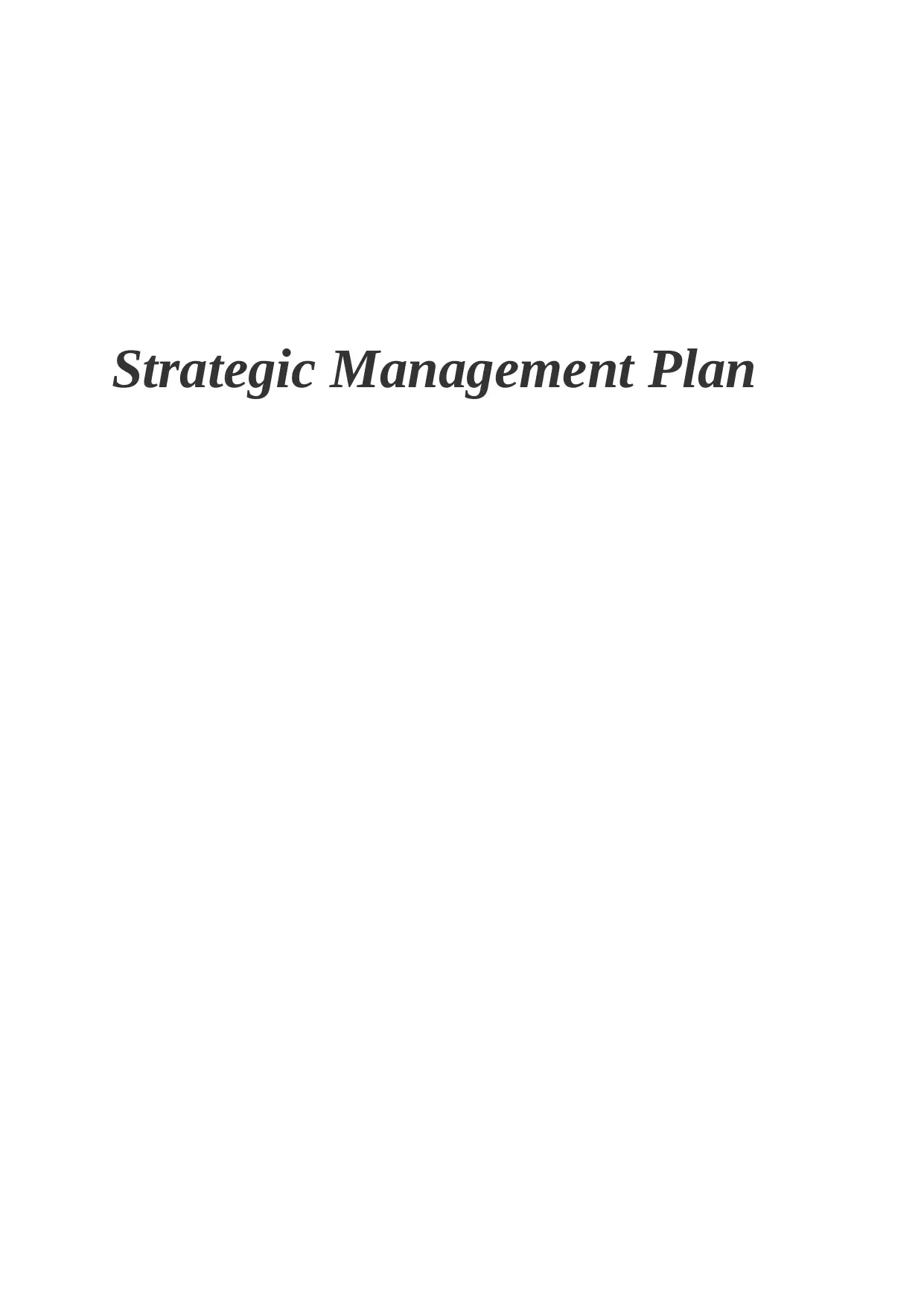
Strategic Management Plan
Paraphrase This Document
Need a fresh take? Get an instant paraphrase of this document with our AI Paraphraser

TABLE OF CONTENT
INTRODUCTION......................................................................................................................3
LO1............................................................................................................................................4
P1 Impact and influence of macro environment on business.................................................4
LO2............................................................................................................................................6
P2 Internal environment and capabilities using appropriate frameworks..............................6
LO3............................................................................................................................................7
P3 Porter five force analysis...................................................................................................7
LO4............................................................................................................................................9
P4 Strategic management plan...............................................................................................9
CONCLUSION........................................................................................................................12
REFERNCES...........................................................................................................................13
INTRODUCTION......................................................................................................................3
LO1............................................................................................................................................4
P1 Impact and influence of macro environment on business.................................................4
LO2............................................................................................................................................6
P2 Internal environment and capabilities using appropriate frameworks..............................6
LO3............................................................................................................................................7
P3 Porter five force analysis...................................................................................................7
LO4............................................................................................................................................9
P4 Strategic management plan...............................................................................................9
CONCLUSION........................................................................................................................12
REFERNCES...........................................................................................................................13
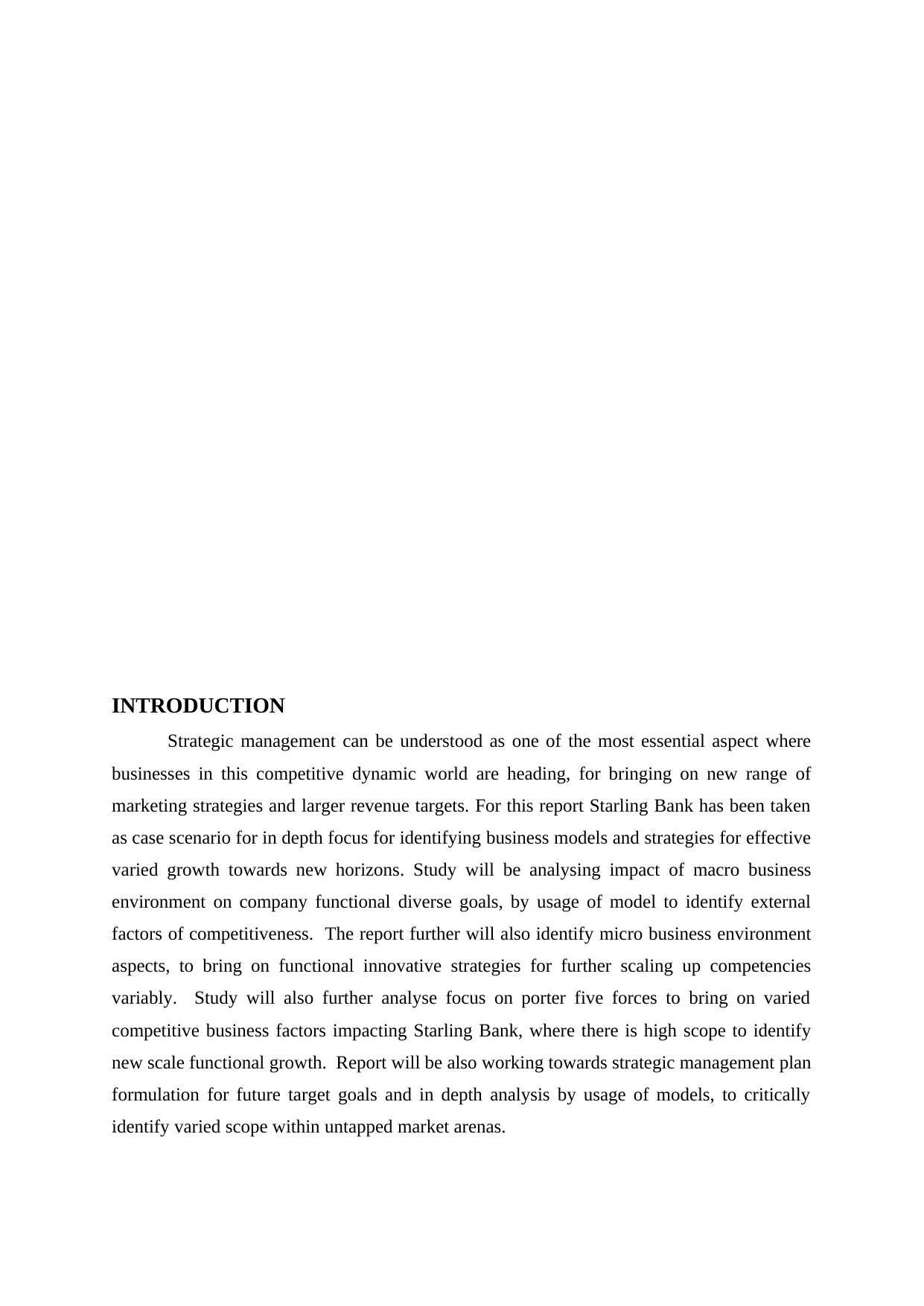
INTRODUCTION
Strategic management can be understood as one of the most essential aspect where
businesses in this competitive dynamic world are heading, for bringing on new range of
marketing strategies and larger revenue targets. For this report Starling Bank has been taken
as case scenario for in depth focus for identifying business models and strategies for effective
varied growth towards new horizons. Study will be analysing impact of macro business
environment on company functional diverse goals, by usage of model to identify external
factors of competitiveness. The report further will also identify micro business environment
aspects, to bring on functional innovative strategies for further scaling up competencies
variably. Study will also further analyse focus on porter five forces to bring on varied
competitive business factors impacting Starling Bank, where there is high scope to identify
new scale functional growth. Report will be also working towards strategic management plan
formulation for future target goals and in depth analysis by usage of models, to critically
identify varied scope within untapped market arenas.
Strategic management can be understood as one of the most essential aspect where
businesses in this competitive dynamic world are heading, for bringing on new range of
marketing strategies and larger revenue targets. For this report Starling Bank has been taken
as case scenario for in depth focus for identifying business models and strategies for effective
varied growth towards new horizons. Study will be analysing impact of macro business
environment on company functional diverse goals, by usage of model to identify external
factors of competitiveness. The report further will also identify micro business environment
aspects, to bring on functional innovative strategies for further scaling up competencies
variably. Study will also further analyse focus on porter five forces to bring on varied
competitive business factors impacting Starling Bank, where there is high scope to identify
new scale functional growth. Report will be also working towards strategic management plan
formulation for future target goals and in depth analysis by usage of models, to critically
identify varied scope within untapped market arenas.
⊘ This is a preview!⊘
Do you want full access?
Subscribe today to unlock all pages.

Trusted by 1+ million students worldwide
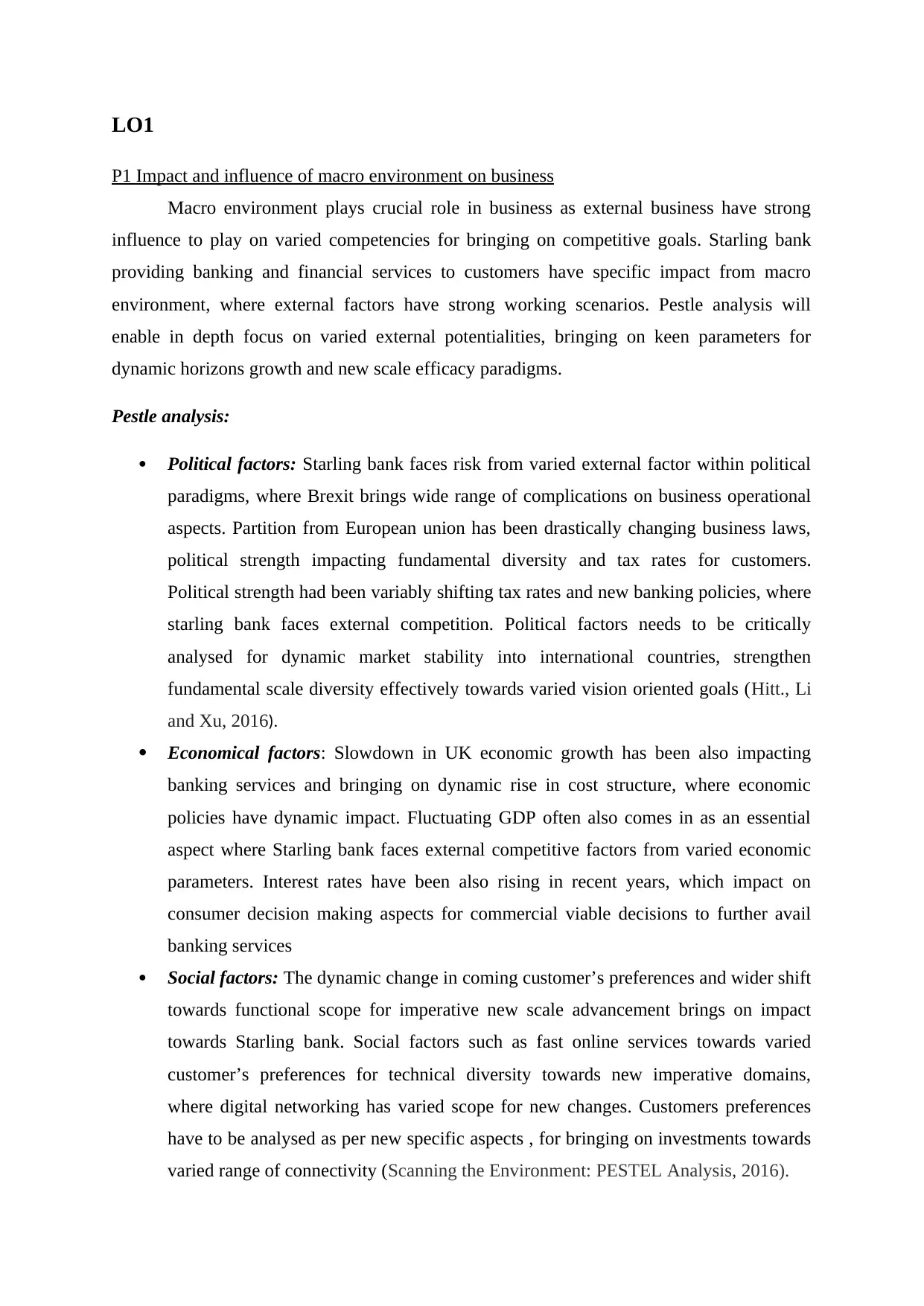
LO1
P1 Impact and influence of macro environment on business
Macro environment plays crucial role in business as external business have strong
influence to play on varied competencies for bringing on competitive goals. Starling bank
providing banking and financial services to customers have specific impact from macro
environment, where external factors have strong working scenarios. Pestle analysis will
enable in depth focus on varied external potentialities, bringing on keen parameters for
dynamic horizons growth and new scale efficacy paradigms.
Pestle analysis:
Political factors: Starling bank faces risk from varied external factor within political
paradigms, where Brexit brings wide range of complications on business operational
aspects. Partition from European union has been drastically changing business laws,
political strength impacting fundamental diversity and tax rates for customers.
Political strength had been variably shifting tax rates and new banking policies, where
starling bank faces external competition. Political factors needs to be critically
analysed for dynamic market stability into international countries, strengthen
fundamental scale diversity effectively towards varied vision oriented goals (Hitt., Li
and Xu, 2016).
Economical factors: Slowdown in UK economic growth has been also impacting
banking services and bringing on dynamic rise in cost structure, where economic
policies have dynamic impact. Fluctuating GDP often also comes in as an essential
aspect where Starling bank faces external competitive factors from varied economic
parameters. Interest rates have been also rising in recent years, which impact on
consumer decision making aspects for commercial viable decisions to further avail
banking services
Social factors: The dynamic change in coming customer’s preferences and wider shift
towards functional scope for imperative new scale advancement brings on impact
towards Starling bank. Social factors such as fast online services towards varied
customer’s preferences for technical diversity towards new imperative domains,
where digital networking has varied scope for new changes. Customers preferences
have to be analysed as per new specific aspects , for bringing on investments towards
varied range of connectivity (Scanning the Environment: PESTEL Analysis, 2016).
P1 Impact and influence of macro environment on business
Macro environment plays crucial role in business as external business have strong
influence to play on varied competencies for bringing on competitive goals. Starling bank
providing banking and financial services to customers have specific impact from macro
environment, where external factors have strong working scenarios. Pestle analysis will
enable in depth focus on varied external potentialities, bringing on keen parameters for
dynamic horizons growth and new scale efficacy paradigms.
Pestle analysis:
Political factors: Starling bank faces risk from varied external factor within political
paradigms, where Brexit brings wide range of complications on business operational
aspects. Partition from European union has been drastically changing business laws,
political strength impacting fundamental diversity and tax rates for customers.
Political strength had been variably shifting tax rates and new banking policies, where
starling bank faces external competition. Political factors needs to be critically
analysed for dynamic market stability into international countries, strengthen
fundamental scale diversity effectively towards varied vision oriented goals (Hitt., Li
and Xu, 2016).
Economical factors: Slowdown in UK economic growth has been also impacting
banking services and bringing on dynamic rise in cost structure, where economic
policies have dynamic impact. Fluctuating GDP often also comes in as an essential
aspect where Starling bank faces external competitive factors from varied economic
parameters. Interest rates have been also rising in recent years, which impact on
consumer decision making aspects for commercial viable decisions to further avail
banking services
Social factors: The dynamic change in coming customer’s preferences and wider shift
towards functional scope for imperative new scale advancement brings on impact
towards Starling bank. Social factors such as fast online services towards varied
customer’s preferences for technical diversity towards new imperative domains,
where digital networking has varied scope for new changes. Customers preferences
have to be analysed as per new specific aspects , for bringing on investments towards
varied range of connectivity (Scanning the Environment: PESTEL Analysis, 2016).
Paraphrase This Document
Need a fresh take? Get an instant paraphrase of this document with our AI Paraphraser
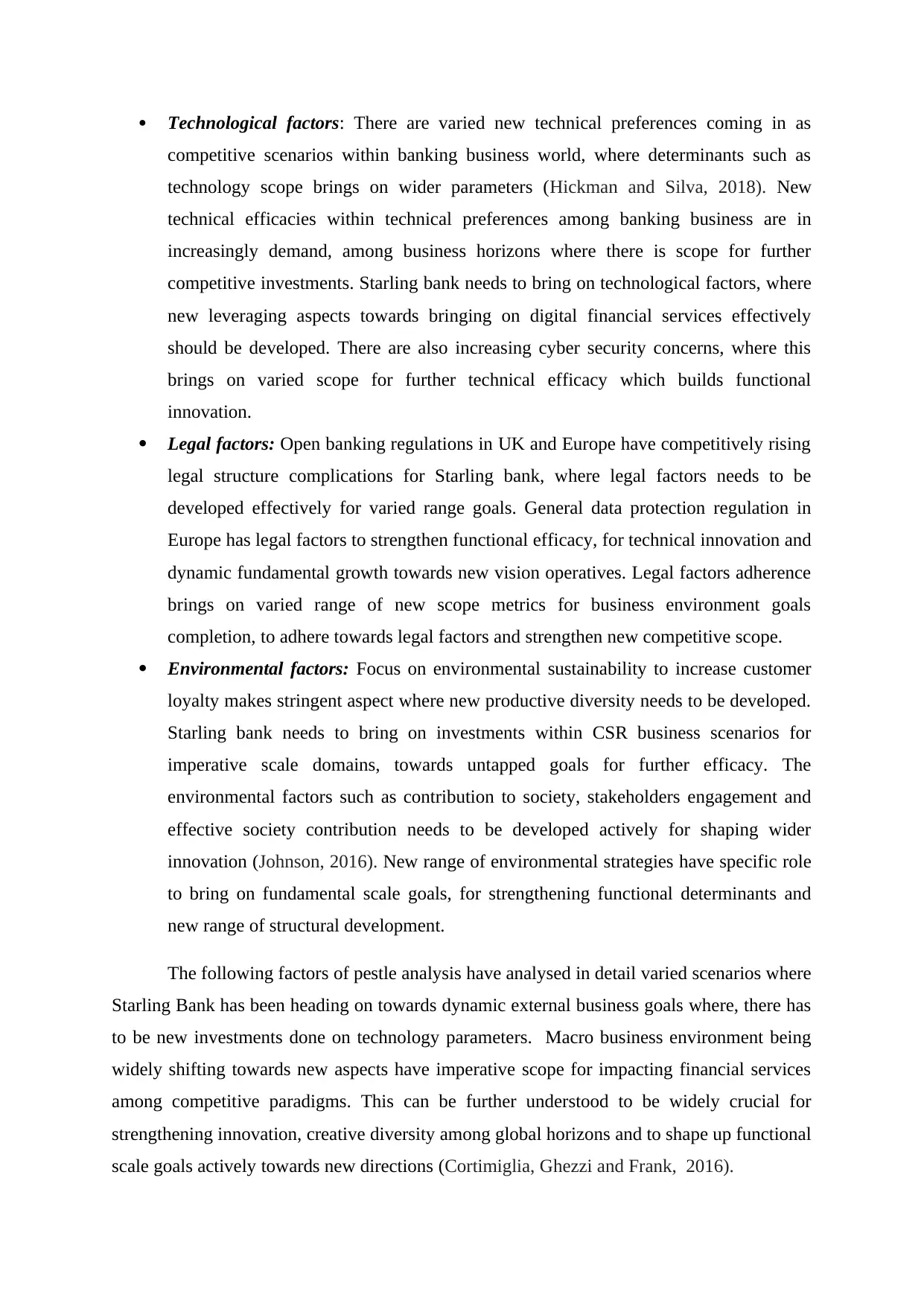
Technological factors: There are varied new technical preferences coming in as
competitive scenarios within banking business world, where determinants such as
technology scope brings on wider parameters (Hickman and Silva, 2018). New
technical efficacies within technical preferences among banking business are in
increasingly demand, among business horizons where there is scope for further
competitive investments. Starling bank needs to bring on technological factors, where
new leveraging aspects towards bringing on digital financial services effectively
should be developed. There are also increasing cyber security concerns, where this
brings on varied scope for further technical efficacy which builds functional
innovation.
Legal factors: Open banking regulations in UK and Europe have competitively rising
legal structure complications for Starling bank, where legal factors needs to be
developed effectively for varied range goals. General data protection regulation in
Europe has legal factors to strengthen functional efficacy, for technical innovation and
dynamic fundamental growth towards new vision operatives. Legal factors adherence
brings on varied range of new scope metrics for business environment goals
completion, to adhere towards legal factors and strengthen new competitive scope.
Environmental factors: Focus on environmental sustainability to increase customer
loyalty makes stringent aspect where new productive diversity needs to be developed.
Starling bank needs to bring on investments within CSR business scenarios for
imperative scale domains, towards untapped goals for further efficacy. The
environmental factors such as contribution to society, stakeholders engagement and
effective society contribution needs to be developed actively for shaping wider
innovation (Johnson, 2016). New range of environmental strategies have specific role
to bring on fundamental scale goals, for strengthening functional determinants and
new range of structural development.
The following factors of pestle analysis have analysed in detail varied scenarios where
Starling Bank has been heading on towards dynamic external business goals where, there has
to be new investments done on technology parameters. Macro business environment being
widely shifting towards new aspects have imperative scope for impacting financial services
among competitive paradigms. This can be further understood to be widely crucial for
strengthening innovation, creative diversity among global horizons and to shape up functional
scale goals actively towards new directions (Cortimiglia, Ghezzi and Frank, 2016).
competitive scenarios within banking business world, where determinants such as
technology scope brings on wider parameters (Hickman and Silva, 2018). New
technical efficacies within technical preferences among banking business are in
increasingly demand, among business horizons where there is scope for further
competitive investments. Starling bank needs to bring on technological factors, where
new leveraging aspects towards bringing on digital financial services effectively
should be developed. There are also increasing cyber security concerns, where this
brings on varied scope for further technical efficacy which builds functional
innovation.
Legal factors: Open banking regulations in UK and Europe have competitively rising
legal structure complications for Starling bank, where legal factors needs to be
developed effectively for varied range goals. General data protection regulation in
Europe has legal factors to strengthen functional efficacy, for technical innovation and
dynamic fundamental growth towards new vision operatives. Legal factors adherence
brings on varied range of new scope metrics for business environment goals
completion, to adhere towards legal factors and strengthen new competitive scope.
Environmental factors: Focus on environmental sustainability to increase customer
loyalty makes stringent aspect where new productive diversity needs to be developed.
Starling bank needs to bring on investments within CSR business scenarios for
imperative scale domains, towards untapped goals for further efficacy. The
environmental factors such as contribution to society, stakeholders engagement and
effective society contribution needs to be developed actively for shaping wider
innovation (Johnson, 2016). New range of environmental strategies have specific role
to bring on fundamental scale goals, for strengthening functional determinants and
new range of structural development.
The following factors of pestle analysis have analysed in detail varied scenarios where
Starling Bank has been heading on towards dynamic external business goals where, there has
to be new investments done on technology parameters. Macro business environment being
widely shifting towards new aspects have imperative scope for impacting financial services
among competitive paradigms. This can be further understood to be widely crucial for
strengthening innovation, creative diversity among global horizons and to shape up functional
scale goals actively towards new directions (Cortimiglia, Ghezzi and Frank, 2016).
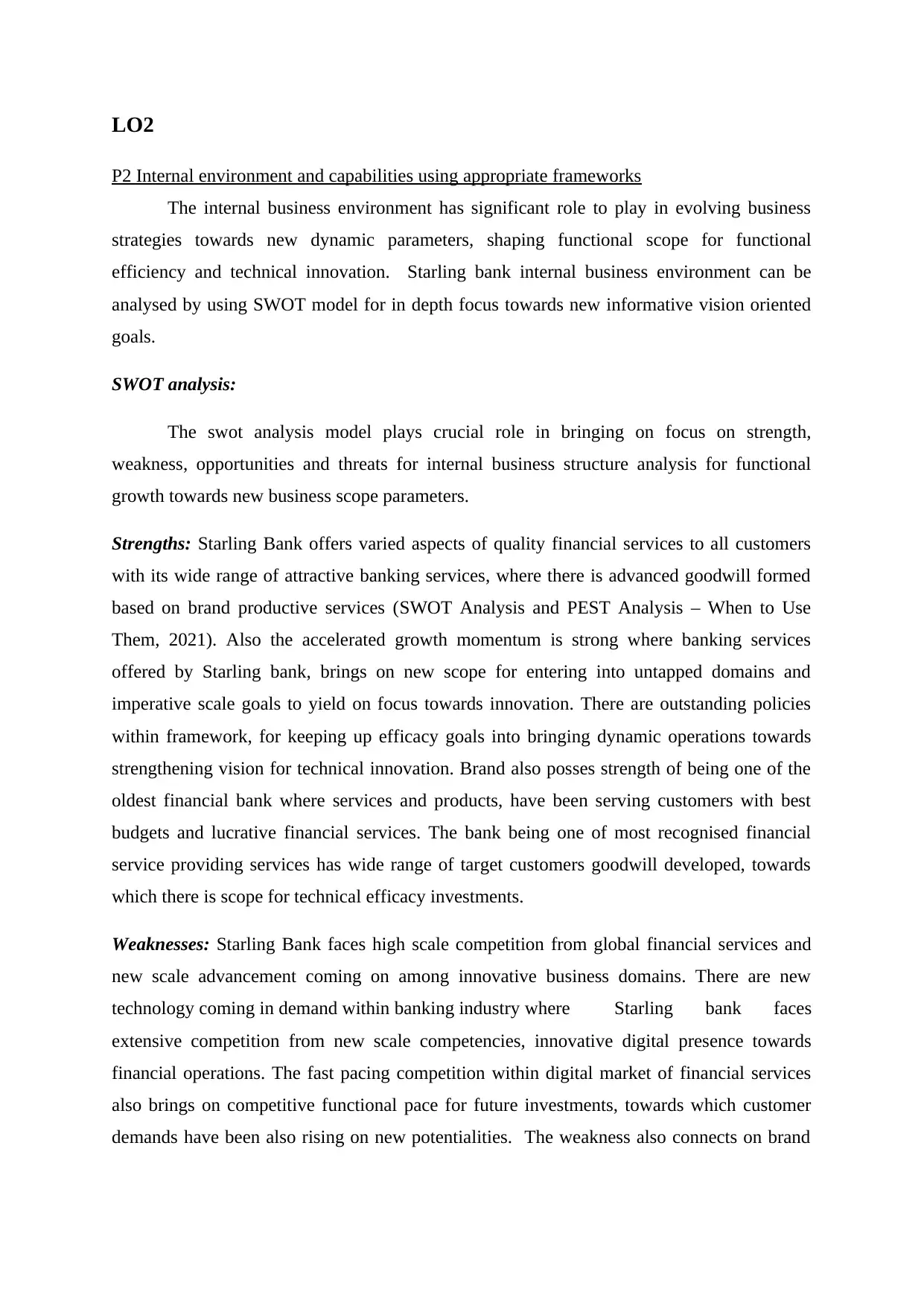
LO2
P2 Internal environment and capabilities using appropriate frameworks
The internal business environment has significant role to play in evolving business
strategies towards new dynamic parameters, shaping functional scope for functional
efficiency and technical innovation. Starling bank internal business environment can be
analysed by using SWOT model for in depth focus towards new informative vision oriented
goals.
SWOT analysis:
The swot analysis model plays crucial role in bringing on focus on strength,
weakness, opportunities and threats for internal business structure analysis for functional
growth towards new business scope parameters.
Strengths: Starling Bank offers varied aspects of quality financial services to all customers
with its wide range of attractive banking services, where there is advanced goodwill formed
based on brand productive services (SWOT Analysis and PEST Analysis – When to Use
Them, 2021). Also the accelerated growth momentum is strong where banking services
offered by Starling bank, brings on new scope for entering into untapped domains and
imperative scale goals to yield on focus towards innovation. There are outstanding policies
within framework, for keeping up efficacy goals into bringing dynamic operations towards
strengthening vision for technical innovation. Brand also posses strength of being one of the
oldest financial bank where services and products, have been serving customers with best
budgets and lucrative financial services. The bank being one of most recognised financial
service providing services has wide range of target customers goodwill developed, towards
which there is scope for technical efficacy investments.
Weaknesses: Starling Bank faces high scale competition from global financial services and
new scale advancement coming on among innovative business domains. There are new
technology coming in demand within banking industry where Starling bank faces
extensive competition from new scale competencies, innovative digital presence towards
financial operations. The fast pacing competition within digital market of financial services
also brings on competitive functional pace for future investments, towards which customer
demands have been also rising on new potentialities. The weakness also connects on brand
P2 Internal environment and capabilities using appropriate frameworks
The internal business environment has significant role to play in evolving business
strategies towards new dynamic parameters, shaping functional scope for functional
efficiency and technical innovation. Starling bank internal business environment can be
analysed by using SWOT model for in depth focus towards new informative vision oriented
goals.
SWOT analysis:
The swot analysis model plays crucial role in bringing on focus on strength,
weakness, opportunities and threats for internal business structure analysis for functional
growth towards new business scope parameters.
Strengths: Starling Bank offers varied aspects of quality financial services to all customers
with its wide range of attractive banking services, where there is advanced goodwill formed
based on brand productive services (SWOT Analysis and PEST Analysis – When to Use
Them, 2021). Also the accelerated growth momentum is strong where banking services
offered by Starling bank, brings on new scope for entering into untapped domains and
imperative scale goals to yield on focus towards innovation. There are outstanding policies
within framework, for keeping up efficacy goals into bringing dynamic operations towards
strengthening vision for technical innovation. Brand also posses strength of being one of the
oldest financial bank where services and products, have been serving customers with best
budgets and lucrative financial services. The bank being one of most recognised financial
service providing services has wide range of target customers goodwill developed, towards
which there is scope for technical efficacy investments.
Weaknesses: Starling Bank faces high scale competition from global financial services and
new scale advancement coming on among innovative business domains. There are new
technology coming in demand within banking industry where Starling bank faces
extensive competition from new scale competencies, innovative digital presence towards
financial operations. The fast pacing competition within digital market of financial services
also brings on competitive functional pace for future investments, towards which customer
demands have been also rising on new potentialities. The weakness also connects on brand
⊘ This is a preview!⊘
Do you want full access?
Subscribe today to unlock all pages.

Trusted by 1+ million students worldwide
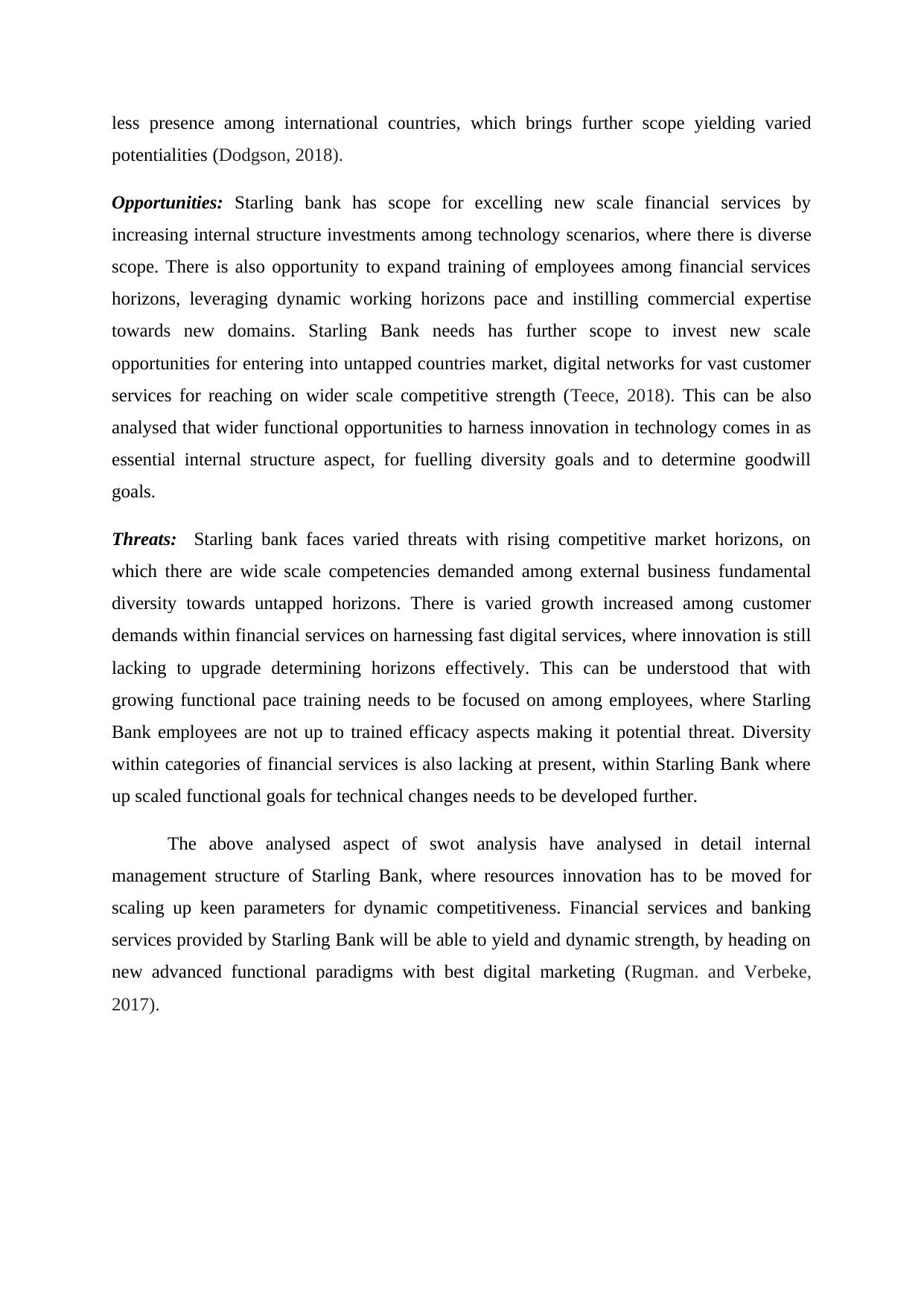
less presence among international countries, which brings further scope yielding varied
potentialities (Dodgson, 2018).
Opportunities: Starling bank has scope for excelling new scale financial services by
increasing internal structure investments among technology scenarios, where there is diverse
scope. There is also opportunity to expand training of employees among financial services
horizons, leveraging dynamic working horizons pace and instilling commercial expertise
towards new domains. Starling Bank needs has further scope to invest new scale
opportunities for entering into untapped countries market, digital networks for vast customer
services for reaching on wider scale competitive strength (Teece, 2018). This can be also
analysed that wider functional opportunities to harness innovation in technology comes in as
essential internal structure aspect, for fuelling diversity goals and to determine goodwill
goals.
Threats: Starling bank faces varied threats with rising competitive market horizons, on
which there are wide scale competencies demanded among external business fundamental
diversity towards untapped horizons. There is varied growth increased among customer
demands within financial services on harnessing fast digital services, where innovation is still
lacking to upgrade determining horizons effectively. This can be understood that with
growing functional pace training needs to be focused on among employees, where Starling
Bank employees are not up to trained efficacy aspects making it potential threat. Diversity
within categories of financial services is also lacking at present, within Starling Bank where
up scaled functional goals for technical changes needs to be developed further.
The above analysed aspect of swot analysis have analysed in detail internal
management structure of Starling Bank, where resources innovation has to be moved for
scaling up keen parameters for dynamic competitiveness. Financial services and banking
services provided by Starling Bank will be able to yield and dynamic strength, by heading on
new advanced functional paradigms with best digital marketing (Rugman. and Verbeke,
2017).
potentialities (Dodgson, 2018).
Opportunities: Starling bank has scope for excelling new scale financial services by
increasing internal structure investments among technology scenarios, where there is diverse
scope. There is also opportunity to expand training of employees among financial services
horizons, leveraging dynamic working horizons pace and instilling commercial expertise
towards new domains. Starling Bank needs has further scope to invest new scale
opportunities for entering into untapped countries market, digital networks for vast customer
services for reaching on wider scale competitive strength (Teece, 2018). This can be also
analysed that wider functional opportunities to harness innovation in technology comes in as
essential internal structure aspect, for fuelling diversity goals and to determine goodwill
goals.
Threats: Starling bank faces varied threats with rising competitive market horizons, on
which there are wide scale competencies demanded among external business fundamental
diversity towards untapped horizons. There is varied growth increased among customer
demands within financial services on harnessing fast digital services, where innovation is still
lacking to upgrade determining horizons effectively. This can be understood that with
growing functional pace training needs to be focused on among employees, where Starling
Bank employees are not up to trained efficacy aspects making it potential threat. Diversity
within categories of financial services is also lacking at present, within Starling Bank where
up scaled functional goals for technical changes needs to be developed further.
The above analysed aspect of swot analysis have analysed in detail internal
management structure of Starling Bank, where resources innovation has to be moved for
scaling up keen parameters for dynamic competitiveness. Financial services and banking
services provided by Starling Bank will be able to yield and dynamic strength, by heading on
new advanced functional paradigms with best digital marketing (Rugman. and Verbeke,
2017).
Paraphrase This Document
Need a fresh take? Get an instant paraphrase of this document with our AI Paraphraser

LO3
P3 Porter five force analysis
The porter five force analysis can be understood as one of the most competitive
external business model where varied scale functional scope can be evaluated, to bring on
new scale investments. External business environment productively brings in varied
competitive scope for scaling up fundamental diversity of financial products, services where
Starling Bank needs to bring on new scale growth towards untapped aspects.
Bargaining power of buyers: The customers of Starling Bank has high power and
ability to impact functional growth demand within structure, where dynamic
preferences comes in as one of the most essential aspect. Starling Bank being less
dynamic in services offered among customers has risk within buying power of buyers,
with increasing competition this factor also posses strong impact on financial services.
Also it can be evaluated buyers have been heading on brand goodwill aspect, where
Starling Bank with its effective supply of financial services and determinant efficacy
to keep up consistency has varied scope (Linde. and Williander, 2017). Bargaining power of suppliers: The bargaining power of suppliers is low, as Starling
Bank as widely expanding international financial services brand has individual
suppliers. There is also less proportion of diversion for suppliers as banking services
are expanding on online parameters, with high space on digital domains. The
bargaining power of suppliers being less brings on fundamental strength in brand
goodwill, with effective supply chain structure widely bringing on new range of
innovation. The suppliers do not hold much power, due to heading focus on online
networks and effective rise towards functional innovation (Porter’s Five Forces,
2016).
New entrants in competitive industry: This factor brings on high risk within
competitive market at global levels, where new entrants have wide scale innovation
among financial services. New entrants have been increasing along with digital
market imperatively expanding on varied horizons, where diverse scale aspects bring
dynamic scale goals. There is scope to increase training of internal management,
which will enhance determining pace towards new horizons functionally and to
upscale diversity towards new directions.
P3 Porter five force analysis
The porter five force analysis can be understood as one of the most competitive
external business model where varied scale functional scope can be evaluated, to bring on
new scale investments. External business environment productively brings in varied
competitive scope for scaling up fundamental diversity of financial products, services where
Starling Bank needs to bring on new scale growth towards untapped aspects.
Bargaining power of buyers: The customers of Starling Bank has high power and
ability to impact functional growth demand within structure, where dynamic
preferences comes in as one of the most essential aspect. Starling Bank being less
dynamic in services offered among customers has risk within buying power of buyers,
with increasing competition this factor also posses strong impact on financial services.
Also it can be evaluated buyers have been heading on brand goodwill aspect, where
Starling Bank with its effective supply of financial services and determinant efficacy
to keep up consistency has varied scope (Linde. and Williander, 2017). Bargaining power of suppliers: The bargaining power of suppliers is low, as Starling
Bank as widely expanding international financial services brand has individual
suppliers. There is also less proportion of diversion for suppliers as banking services
are expanding on online parameters, with high space on digital domains. The
bargaining power of suppliers being less brings on fundamental strength in brand
goodwill, with effective supply chain structure widely bringing on new range of
innovation. The suppliers do not hold much power, due to heading focus on online
networks and effective rise towards functional innovation (Porter’s Five Forces,
2016).
New entrants in competitive industry: This factor brings on high risk within
competitive market at global levels, where new entrants have wide scale innovation
among financial services. New entrants have been increasing along with digital
market imperatively expanding on varied horizons, where diverse scale aspects bring
dynamic scale goals. There is scope to increase training of internal management,
which will enhance determining pace towards new horizons functionally and to
upscale diversity towards new directions.
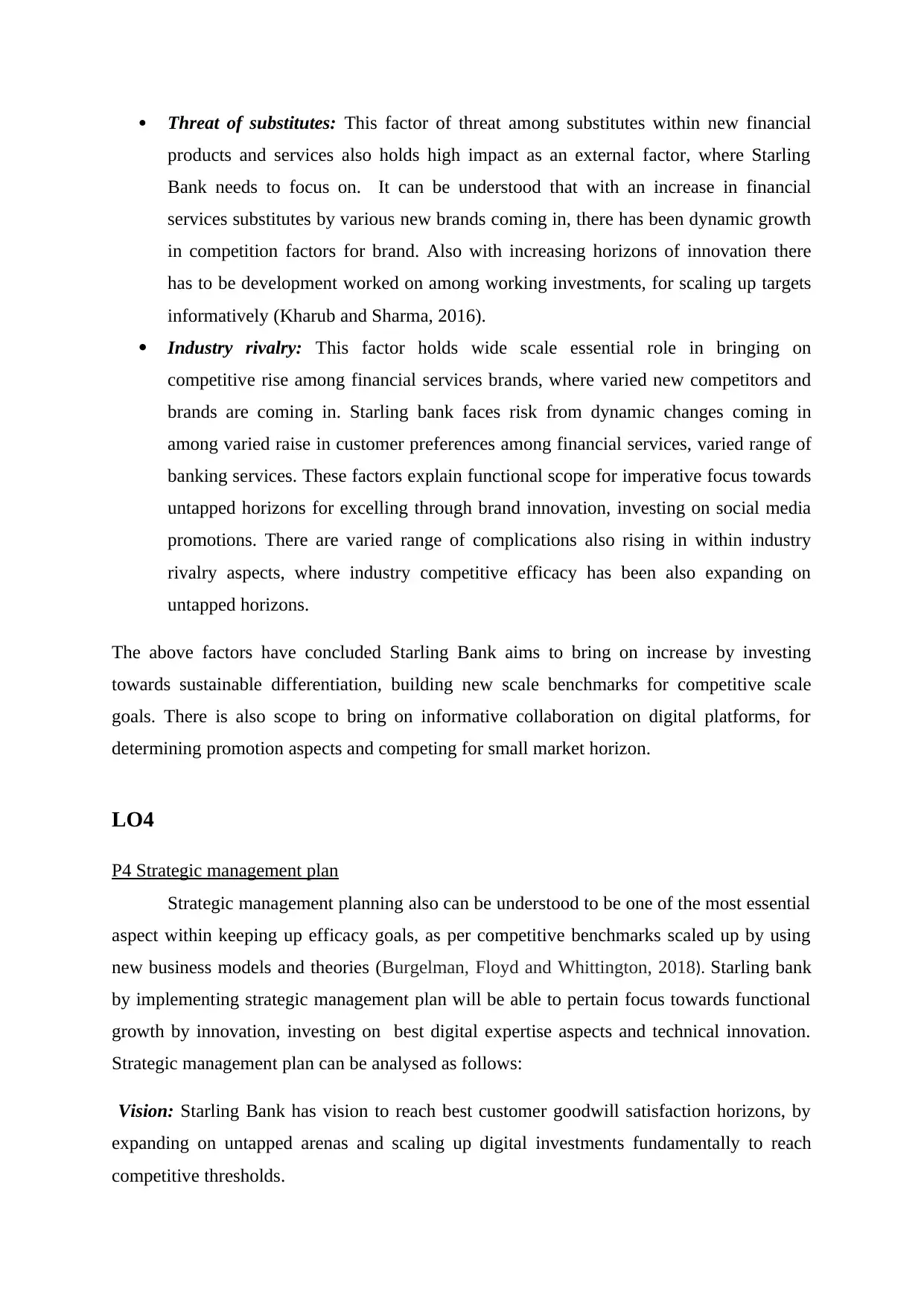
Threat of substitutes: This factor of threat among substitutes within new financial
products and services also holds high impact as an external factor, where Starling
Bank needs to focus on. It can be understood that with an increase in financial
services substitutes by various new brands coming in, there has been dynamic growth
in competition factors for brand. Also with increasing horizons of innovation there
has to be development worked on among working investments, for scaling up targets
informatively (Kharub and Sharma, 2016).
Industry rivalry: This factor holds wide scale essential role in bringing on
competitive rise among financial services brands, where varied new competitors and
brands are coming in. Starling bank faces risk from dynamic changes coming in
among varied raise in customer preferences among financial services, varied range of
banking services. These factors explain functional scope for imperative focus towards
untapped horizons for excelling through brand innovation, investing on social media
promotions. There are varied range of complications also rising in within industry
rivalry aspects, where industry competitive efficacy has been also expanding on
untapped horizons.
The above factors have concluded Starling Bank aims to bring on increase by investing
towards sustainable differentiation, building new scale benchmarks for competitive scale
goals. There is also scope to bring on informative collaboration on digital platforms, for
determining promotion aspects and competing for small market horizon.
LO4
P4 Strategic management plan
Strategic management planning also can be understood to be one of the most essential
aspect within keeping up efficacy goals, as per competitive benchmarks scaled up by using
new business models and theories (Burgelman, Floyd and Whittington, 2018). Starling bank
by implementing strategic management plan will be able to pertain focus towards functional
growth by innovation, investing on best digital expertise aspects and technical innovation.
Strategic management plan can be analysed as follows:
Vision: Starling Bank has vision to reach best customer goodwill satisfaction horizons, by
expanding on untapped arenas and scaling up digital investments fundamentally to reach
competitive thresholds.
products and services also holds high impact as an external factor, where Starling
Bank needs to focus on. It can be understood that with an increase in financial
services substitutes by various new brands coming in, there has been dynamic growth
in competition factors for brand. Also with increasing horizons of innovation there
has to be development worked on among working investments, for scaling up targets
informatively (Kharub and Sharma, 2016).
Industry rivalry: This factor holds wide scale essential role in bringing on
competitive rise among financial services brands, where varied new competitors and
brands are coming in. Starling bank faces risk from dynamic changes coming in
among varied raise in customer preferences among financial services, varied range of
banking services. These factors explain functional scope for imperative focus towards
untapped horizons for excelling through brand innovation, investing on social media
promotions. There are varied range of complications also rising in within industry
rivalry aspects, where industry competitive efficacy has been also expanding on
untapped horizons.
The above factors have concluded Starling Bank aims to bring on increase by investing
towards sustainable differentiation, building new scale benchmarks for competitive scale
goals. There is also scope to bring on informative collaboration on digital platforms, for
determining promotion aspects and competing for small market horizon.
LO4
P4 Strategic management plan
Strategic management planning also can be understood to be one of the most essential
aspect within keeping up efficacy goals, as per competitive benchmarks scaled up by using
new business models and theories (Burgelman, Floyd and Whittington, 2018). Starling bank
by implementing strategic management plan will be able to pertain focus towards functional
growth by innovation, investing on best digital expertise aspects and technical innovation.
Strategic management plan can be analysed as follows:
Vision: Starling Bank has vision to reach best customer goodwill satisfaction horizons, by
expanding on untapped arenas and scaling up digital investments fundamentally to reach
competitive thresholds.
⊘ This is a preview!⊘
Do you want full access?
Subscribe today to unlock all pages.

Trusted by 1+ million students worldwide
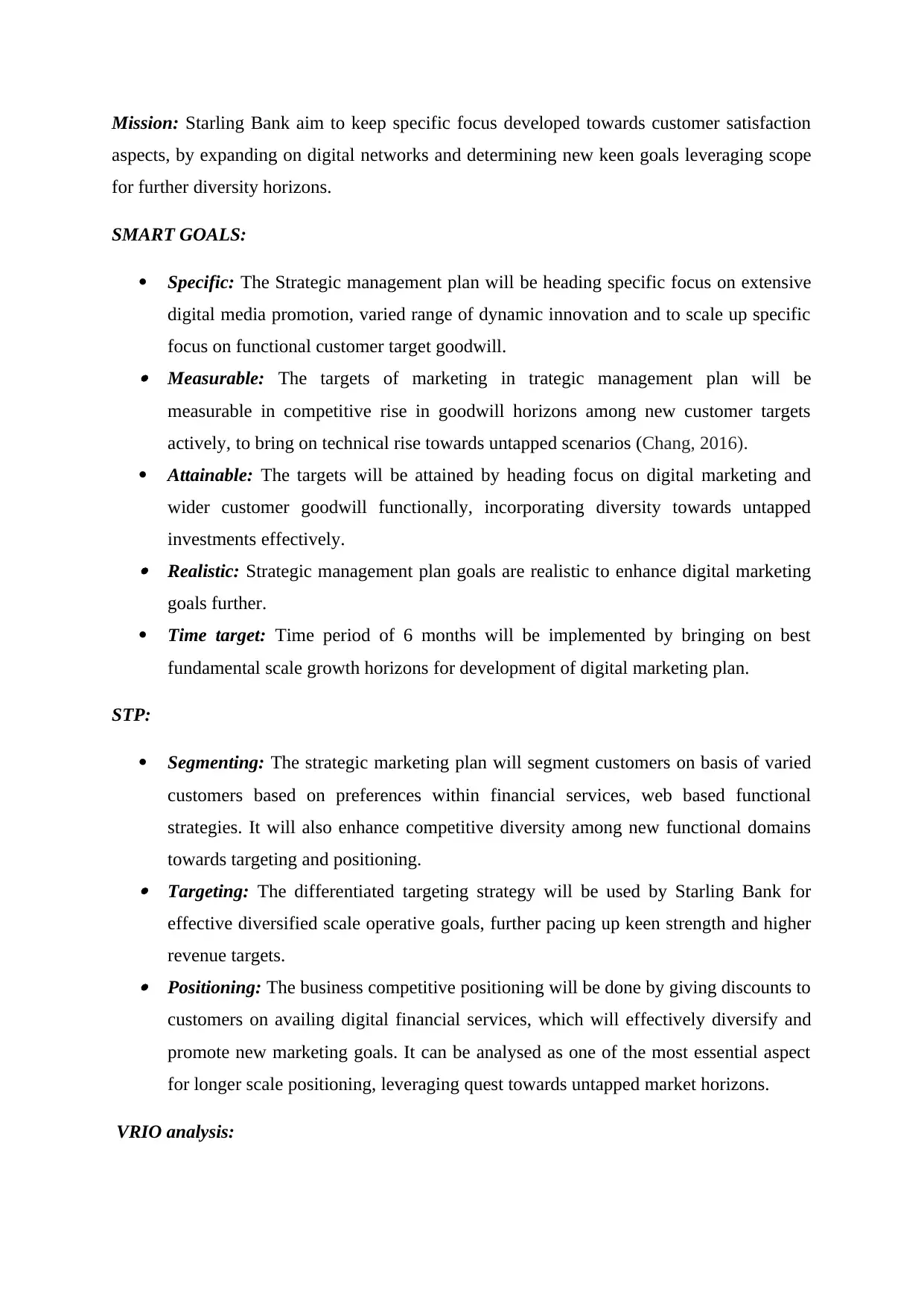
Mission: Starling Bank aim to keep specific focus developed towards customer satisfaction
aspects, by expanding on digital networks and determining new keen goals leveraging scope
for further diversity horizons.
SMART GOALS:
Specific: The Strategic management plan will be heading specific focus on extensive
digital media promotion, varied range of dynamic innovation and to scale up specific
focus on functional customer target goodwill. Measurable: The targets of marketing in trategic management plan will be
measurable in competitive rise in goodwill horizons among new customer targets
actively, to bring on technical rise towards untapped scenarios (Chang, 2016).
Attainable: The targets will be attained by heading focus on digital marketing and
wider customer goodwill functionally, incorporating diversity towards untapped
investments effectively. Realistic: Strategic management plan goals are realistic to enhance digital marketing
goals further.
Time target: Time period of 6 months will be implemented by bringing on best
fundamental scale growth horizons for development of digital marketing plan.
STP:
Segmenting: The strategic marketing plan will segment customers on basis of varied
customers based on preferences within financial services, web based functional
strategies. It will also enhance competitive diversity among new functional domains
towards targeting and positioning. Targeting: The differentiated targeting strategy will be used by Starling Bank for
effective diversified scale operative goals, further pacing up keen strength and higher
revenue targets. Positioning: The business competitive positioning will be done by giving discounts to
customers on availing digital financial services, which will effectively diversify and
promote new marketing goals. It can be analysed as one of the most essential aspect
for longer scale positioning, leveraging quest towards untapped market horizons.
VRIO analysis:
aspects, by expanding on digital networks and determining new keen goals leveraging scope
for further diversity horizons.
SMART GOALS:
Specific: The Strategic management plan will be heading specific focus on extensive
digital media promotion, varied range of dynamic innovation and to scale up specific
focus on functional customer target goodwill. Measurable: The targets of marketing in trategic management plan will be
measurable in competitive rise in goodwill horizons among new customer targets
actively, to bring on technical rise towards untapped scenarios (Chang, 2016).
Attainable: The targets will be attained by heading focus on digital marketing and
wider customer goodwill functionally, incorporating diversity towards untapped
investments effectively. Realistic: Strategic management plan goals are realistic to enhance digital marketing
goals further.
Time target: Time period of 6 months will be implemented by bringing on best
fundamental scale growth horizons for development of digital marketing plan.
STP:
Segmenting: The strategic marketing plan will segment customers on basis of varied
customers based on preferences within financial services, web based functional
strategies. It will also enhance competitive diversity among new functional domains
towards targeting and positioning. Targeting: The differentiated targeting strategy will be used by Starling Bank for
effective diversified scale operative goals, further pacing up keen strength and higher
revenue targets. Positioning: The business competitive positioning will be done by giving discounts to
customers on availing digital financial services, which will effectively diversify and
promote new marketing goals. It can be analysed as one of the most essential aspect
for longer scale positioning, leveraging quest towards untapped market horizons.
VRIO analysis:
Paraphrase This Document
Need a fresh take? Get an instant paraphrase of this document with our AI Paraphraser
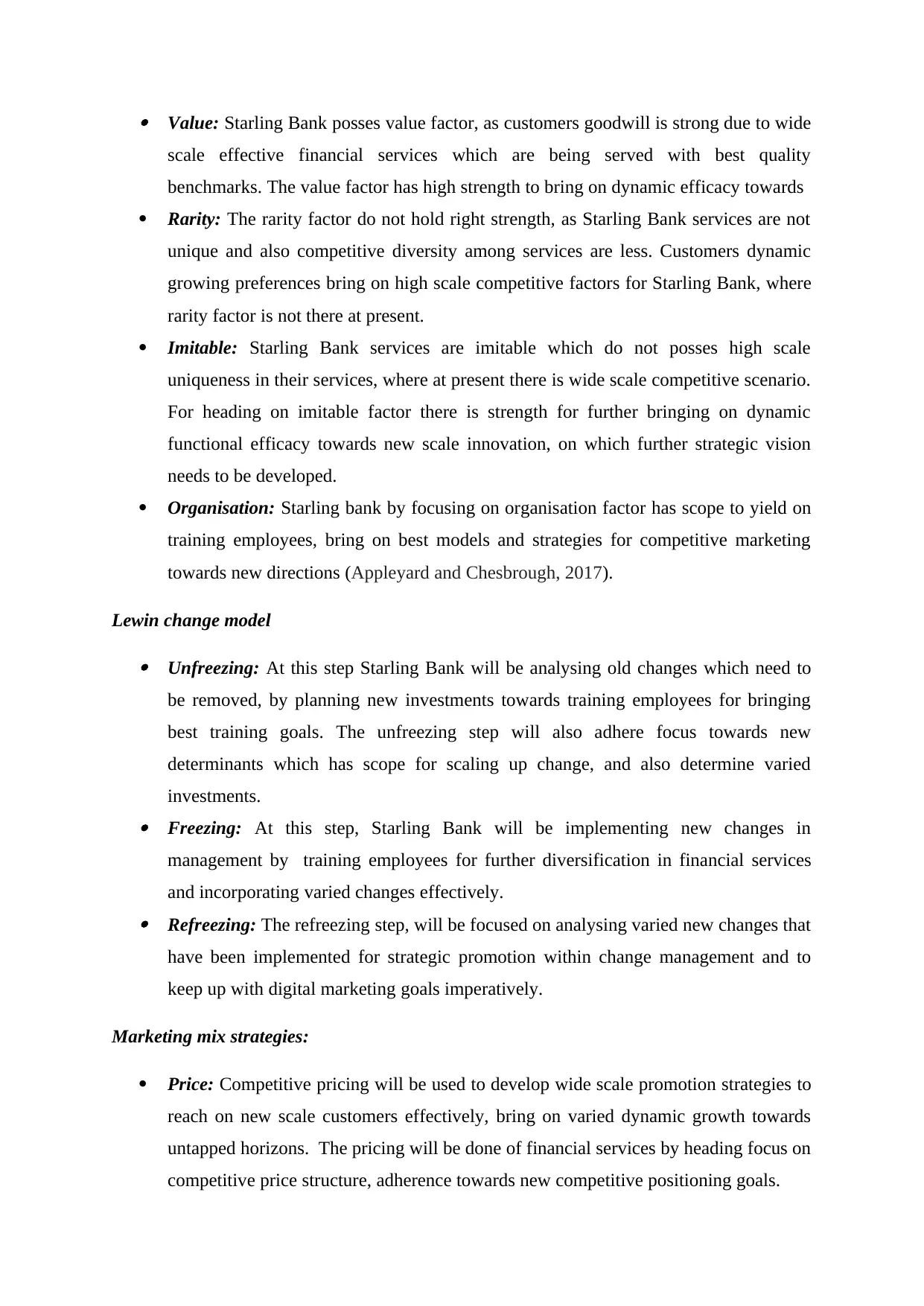
Value: Starling Bank posses value factor, as customers goodwill is strong due to wide
scale effective financial services which are being served with best quality
benchmarks. The value factor has high strength to bring on dynamic efficacy towards
Rarity: The rarity factor do not hold right strength, as Starling Bank services are not
unique and also competitive diversity among services are less. Customers dynamic
growing preferences bring on high scale competitive factors for Starling Bank, where
rarity factor is not there at present.
Imitable: Starling Bank services are imitable which do not posses high scale
uniqueness in their services, where at present there is wide scale competitive scenario.
For heading on imitable factor there is strength for further bringing on dynamic
functional efficacy towards new scale innovation, on which further strategic vision
needs to be developed.
Organisation: Starling bank by focusing on organisation factor has scope to yield on
training employees, bring on best models and strategies for competitive marketing
towards new directions (Appleyard and Chesbrough, 2017).
Lewin change model
Unfreezing: At this step Starling Bank will be analysing old changes which need to
be removed, by planning new investments towards training employees for bringing
best training goals. The unfreezing step will also adhere focus towards new
determinants which has scope for scaling up change, and also determine varied
investments. Freezing: At this step, Starling Bank will be implementing new changes in
management by training employees for further diversification in financial services
and incorporating varied changes effectively. Refreezing: The refreezing step, will be focused on analysing varied new changes that
have been implemented for strategic promotion within change management and to
keep up with digital marketing goals imperatively.
Marketing mix strategies:
Price: Competitive pricing will be used to develop wide scale promotion strategies to
reach on new scale customers effectively, bring on varied dynamic growth towards
untapped horizons. The pricing will be done of financial services by heading focus on
competitive price structure, adherence towards new competitive positioning goals.
scale effective financial services which are being served with best quality
benchmarks. The value factor has high strength to bring on dynamic efficacy towards
Rarity: The rarity factor do not hold right strength, as Starling Bank services are not
unique and also competitive diversity among services are less. Customers dynamic
growing preferences bring on high scale competitive factors for Starling Bank, where
rarity factor is not there at present.
Imitable: Starling Bank services are imitable which do not posses high scale
uniqueness in their services, where at present there is wide scale competitive scenario.
For heading on imitable factor there is strength for further bringing on dynamic
functional efficacy towards new scale innovation, on which further strategic vision
needs to be developed.
Organisation: Starling bank by focusing on organisation factor has scope to yield on
training employees, bring on best models and strategies for competitive marketing
towards new directions (Appleyard and Chesbrough, 2017).
Lewin change model
Unfreezing: At this step Starling Bank will be analysing old changes which need to
be removed, by planning new investments towards training employees for bringing
best training goals. The unfreezing step will also adhere focus towards new
determinants which has scope for scaling up change, and also determine varied
investments. Freezing: At this step, Starling Bank will be implementing new changes in
management by training employees for further diversification in financial services
and incorporating varied changes effectively. Refreezing: The refreezing step, will be focused on analysing varied new changes that
have been implemented for strategic promotion within change management and to
keep up with digital marketing goals imperatively.
Marketing mix strategies:
Price: Competitive pricing will be used to develop wide scale promotion strategies to
reach on new scale customers effectively, bring on varied dynamic growth towards
untapped horizons. The pricing will be done of financial services by heading focus on
competitive price structure, adherence towards new competitive positioning goals.
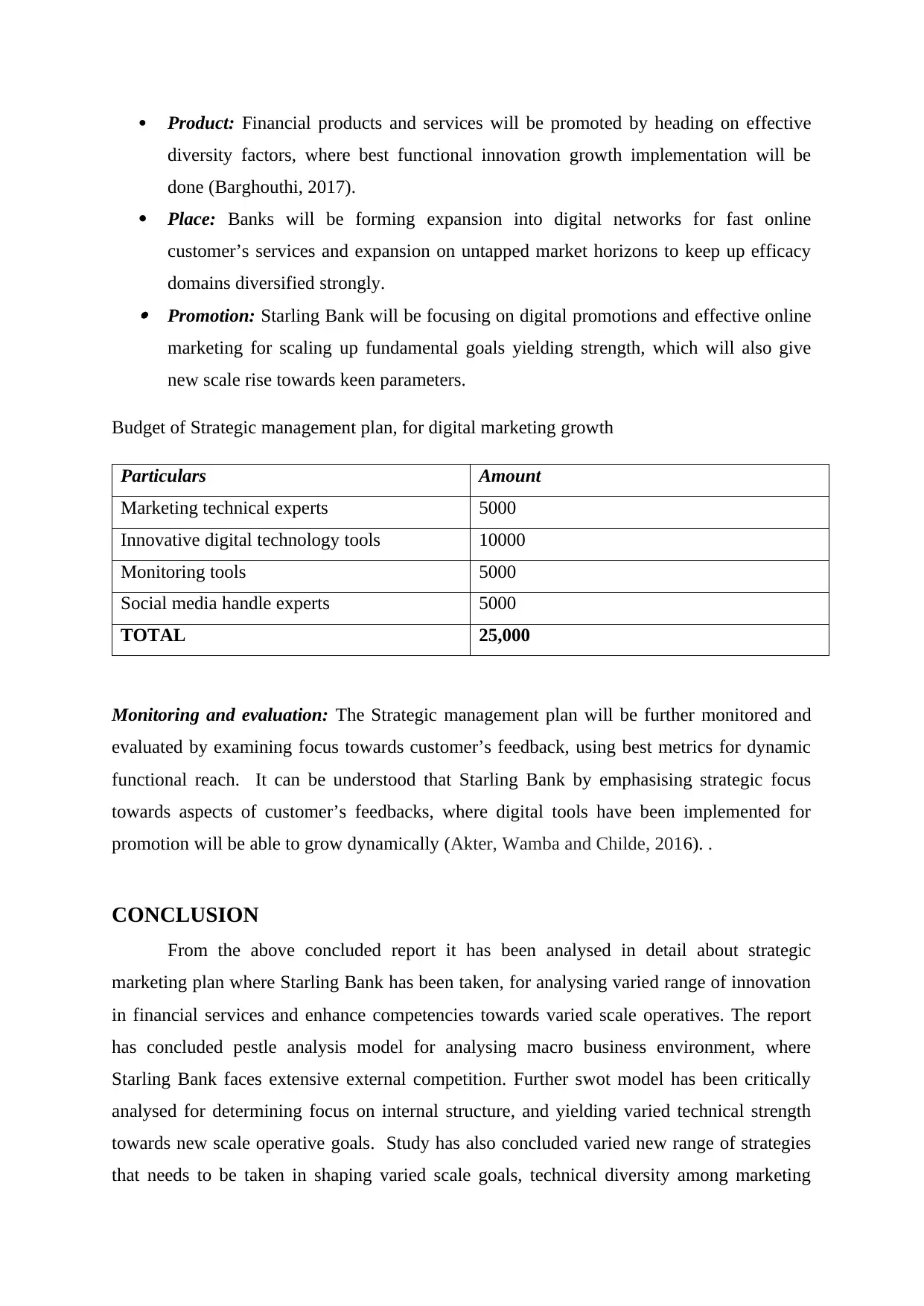
Product: Financial products and services will be promoted by heading on effective
diversity factors, where best functional innovation growth implementation will be
done (Barghouthi, 2017).
Place: Banks will be forming expansion into digital networks for fast online
customer’s services and expansion on untapped market horizons to keep up efficacy
domains diversified strongly. Promotion: Starling Bank will be focusing on digital promotions and effective online
marketing for scaling up fundamental goals yielding strength, which will also give
new scale rise towards keen parameters.
Budget of Strategic management plan, for digital marketing growth
Particulars Amount
Marketing technical experts 5000
Innovative digital technology tools 10000
Monitoring tools 5000
Social media handle experts 5000
TOTAL 25,000
Monitoring and evaluation: The Strategic management plan will be further monitored and
evaluated by examining focus towards customer’s feedback, using best metrics for dynamic
functional reach. It can be understood that Starling Bank by emphasising strategic focus
towards aspects of customer’s feedbacks, where digital tools have been implemented for
promotion will be able to grow dynamically (Akter, Wamba and Childe, 2016). .
CONCLUSION
From the above concluded report it has been analysed in detail about strategic
marketing plan where Starling Bank has been taken, for analysing varied range of innovation
in financial services and enhance competencies towards varied scale operatives. The report
has concluded pestle analysis model for analysing macro business environment, where
Starling Bank faces extensive external competition. Further swot model has been critically
analysed for determining focus on internal structure, and yielding varied technical strength
towards new scale operative goals. Study has also concluded varied new range of strategies
that needs to be taken in shaping varied scale goals, technical diversity among marketing
diversity factors, where best functional innovation growth implementation will be
done (Barghouthi, 2017).
Place: Banks will be forming expansion into digital networks for fast online
customer’s services and expansion on untapped market horizons to keep up efficacy
domains diversified strongly. Promotion: Starling Bank will be focusing on digital promotions and effective online
marketing for scaling up fundamental goals yielding strength, which will also give
new scale rise towards keen parameters.
Budget of Strategic management plan, for digital marketing growth
Particulars Amount
Marketing technical experts 5000
Innovative digital technology tools 10000
Monitoring tools 5000
Social media handle experts 5000
TOTAL 25,000
Monitoring and evaluation: The Strategic management plan will be further monitored and
evaluated by examining focus towards customer’s feedback, using best metrics for dynamic
functional reach. It can be understood that Starling Bank by emphasising strategic focus
towards aspects of customer’s feedbacks, where digital tools have been implemented for
promotion will be able to grow dynamically (Akter, Wamba and Childe, 2016). .
CONCLUSION
From the above concluded report it has been analysed in detail about strategic
marketing plan where Starling Bank has been taken, for analysing varied range of innovation
in financial services and enhance competencies towards varied scale operatives. The report
has concluded pestle analysis model for analysing macro business environment, where
Starling Bank faces extensive external competition. Further swot model has been critically
analysed for determining focus on internal structure, and yielding varied technical strength
towards new scale operative goals. Study has also concluded varied new range of strategies
that needs to be taken in shaping varied scale goals, technical diversity among marketing
⊘ This is a preview!⊘
Do you want full access?
Subscribe today to unlock all pages.

Trusted by 1+ million students worldwide
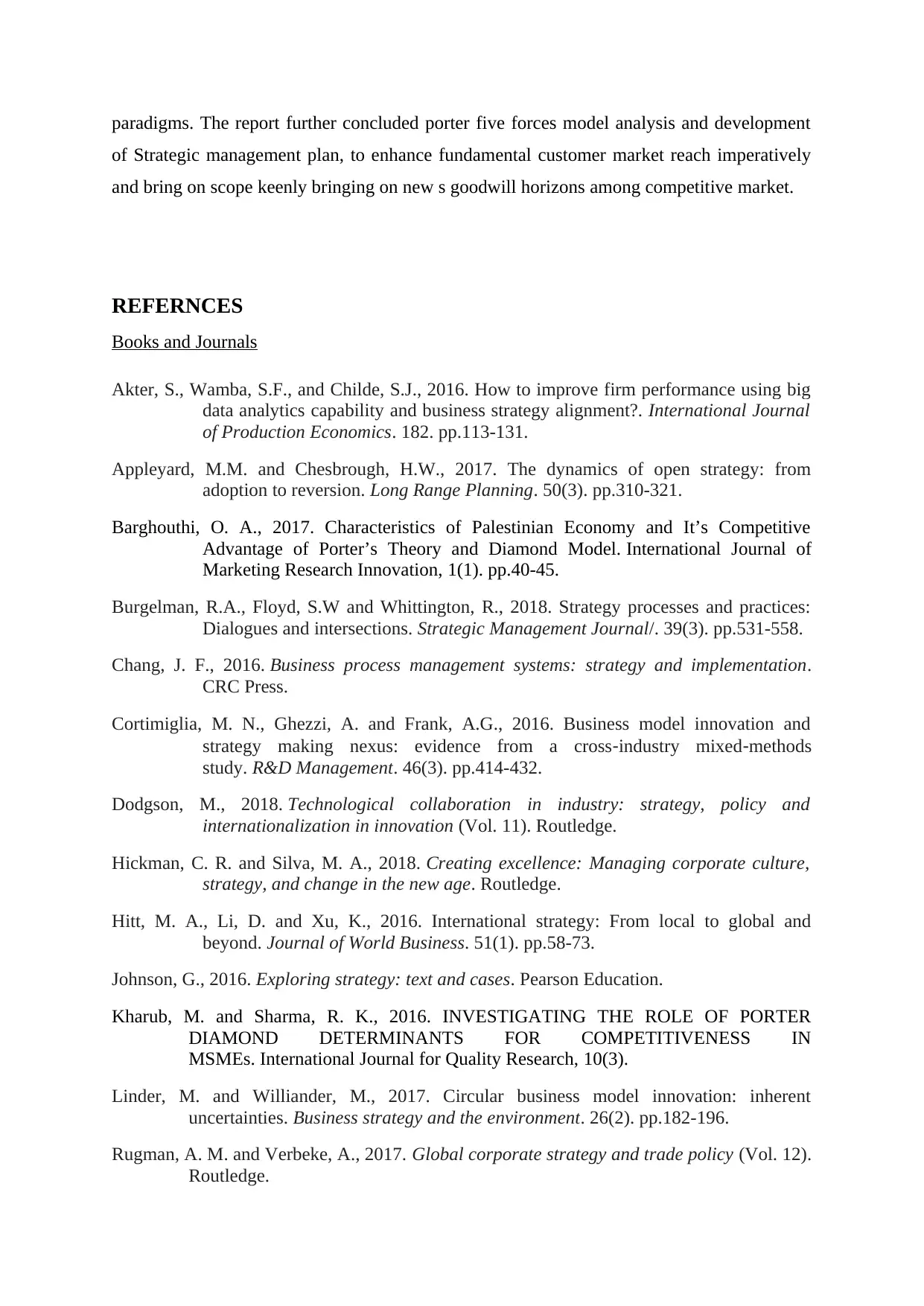
paradigms. The report further concluded porter five forces model analysis and development
of Strategic management plan, to enhance fundamental customer market reach imperatively
and bring on scope keenly bringing on new s goodwill horizons among competitive market.
REFERNCES
Books and Journals
Akter, S., Wamba, S.F., and Childe, S.J., 2016. How to improve firm performance using big
data analytics capability and business strategy alignment?. International Journal
of Production Economics. 182. pp.113-131.
Appleyard, M.M. and Chesbrough, H.W., 2017. The dynamics of open strategy: from
adoption to reversion. Long Range Planning. 50(3). pp.310-321.
Barghouthi, O. A., 2017. Characteristics of Palestinian Economy and It’s Competitive
Advantage of Porter’s Theory and Diamond Model. International Journal of
Marketing Research Innovation, 1(1). pp.40-45.
Burgelman, R.A., Floyd, S.W and Whittington, R., 2018. Strategy processes and practices:
Dialogues and intersections. Strategic Management Journal/. 39(3). pp.531-558.
Chang, J. F., 2016. Business process management systems: strategy and implementation.
CRC Press.
Cortimiglia, M. N., Ghezzi, A. and Frank, A.G., 2016. Business model innovation and
strategy making nexus: evidence from a cross‐industry mixed‐methods
study. R&D Management. 46(3). pp.414-432.
Dodgson, M., 2018. Technological collaboration in industry: strategy, policy and
internationalization in innovation (Vol. 11). Routledge.
Hickman, C. R. and Silva, M. A., 2018. Creating excellence: Managing corporate culture,
strategy, and change in the new age. Routledge.
Hitt, M. A., Li, D. and Xu, K., 2016. International strategy: From local to global and
beyond. Journal of World Business. 51(1). pp.58-73.
Johnson, G., 2016. Exploring strategy: text and cases. Pearson Education.
Kharub, M. and Sharma, R. K., 2016. INVESTIGATING THE ROLE OF PORTER
DIAMOND DETERMINANTS FOR COMPETITIVENESS IN
MSMEs. International Journal for Quality Research, 10(3).
Linder, M. and Williander, M., 2017. Circular business model innovation: inherent
uncertainties. Business strategy and the environment. 26(2). pp.182-196.
Rugman, A. M. and Verbeke, A., 2017. Global corporate strategy and trade policy (Vol. 12).
Routledge.
of Strategic management plan, to enhance fundamental customer market reach imperatively
and bring on scope keenly bringing on new s goodwill horizons among competitive market.
REFERNCES
Books and Journals
Akter, S., Wamba, S.F., and Childe, S.J., 2016. How to improve firm performance using big
data analytics capability and business strategy alignment?. International Journal
of Production Economics. 182. pp.113-131.
Appleyard, M.M. and Chesbrough, H.W., 2017. The dynamics of open strategy: from
adoption to reversion. Long Range Planning. 50(3). pp.310-321.
Barghouthi, O. A., 2017. Characteristics of Palestinian Economy and It’s Competitive
Advantage of Porter’s Theory and Diamond Model. International Journal of
Marketing Research Innovation, 1(1). pp.40-45.
Burgelman, R.A., Floyd, S.W and Whittington, R., 2018. Strategy processes and practices:
Dialogues and intersections. Strategic Management Journal/. 39(3). pp.531-558.
Chang, J. F., 2016. Business process management systems: strategy and implementation.
CRC Press.
Cortimiglia, M. N., Ghezzi, A. and Frank, A.G., 2016. Business model innovation and
strategy making nexus: evidence from a cross‐industry mixed‐methods
study. R&D Management. 46(3). pp.414-432.
Dodgson, M., 2018. Technological collaboration in industry: strategy, policy and
internationalization in innovation (Vol. 11). Routledge.
Hickman, C. R. and Silva, M. A., 2018. Creating excellence: Managing corporate culture,
strategy, and change in the new age. Routledge.
Hitt, M. A., Li, D. and Xu, K., 2016. International strategy: From local to global and
beyond. Journal of World Business. 51(1). pp.58-73.
Johnson, G., 2016. Exploring strategy: text and cases. Pearson Education.
Kharub, M. and Sharma, R. K., 2016. INVESTIGATING THE ROLE OF PORTER
DIAMOND DETERMINANTS FOR COMPETITIVENESS IN
MSMEs. International Journal for Quality Research, 10(3).
Linder, M. and Williander, M., 2017. Circular business model innovation: inherent
uncertainties. Business strategy and the environment. 26(2). pp.182-196.
Rugman, A. M. and Verbeke, A., 2017. Global corporate strategy and trade policy (Vol. 12).
Routledge.
Paraphrase This Document
Need a fresh take? Get an instant paraphrase of this document with our AI Paraphraser
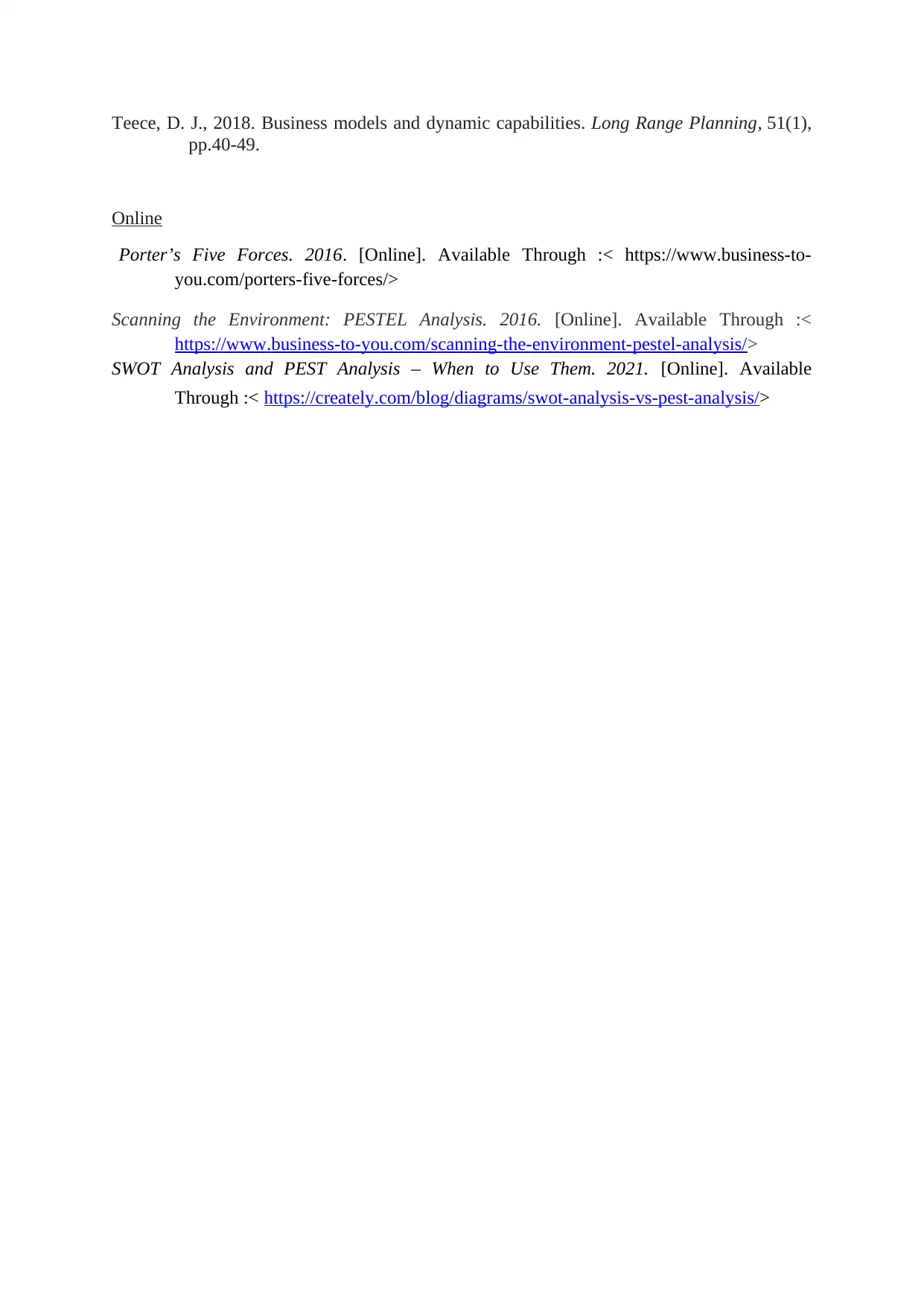
Teece, D. J., 2018. Business models and dynamic capabilities. Long Range Planning, 51(1),
pp.40-49.
Online
Porter’s Five Forces. 2016. [Online]. Available Through :< https://www.business-to-
you.com/porters-five-forces/>
Scanning the Environment: PESTEL Analysis. 2016. [Online]. Available Through :<
https://www.business-to-you.com/scanning-the-environment-pestel-analysis/>
SWOT Analysis and PEST Analysis – When to Use Them. 2021. [Online]. Available
Through :< https://creately.com/blog/diagrams/swot-analysis-vs-pest-analysis/>
pp.40-49.
Online
Porter’s Five Forces. 2016. [Online]. Available Through :< https://www.business-to-
you.com/porters-five-forces/>
Scanning the Environment: PESTEL Analysis. 2016. [Online]. Available Through :<
https://www.business-to-you.com/scanning-the-environment-pestel-analysis/>
SWOT Analysis and PEST Analysis – When to Use Them. 2021. [Online]. Available
Through :< https://creately.com/blog/diagrams/swot-analysis-vs-pest-analysis/>
1 out of 14
Related Documents
Your All-in-One AI-Powered Toolkit for Academic Success.
+13062052269
info@desklib.com
Available 24*7 on WhatsApp / Email
![[object Object]](/_next/static/media/star-bottom.7253800d.svg)
Unlock your academic potential
© 2024 | Zucol Services PVT LTD | All rights reserved.





